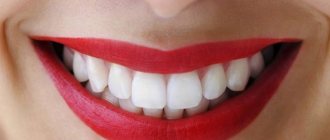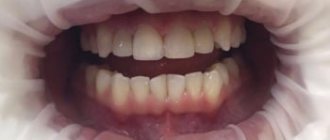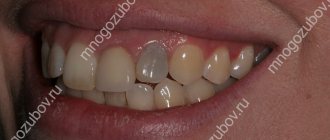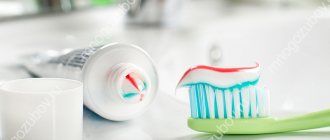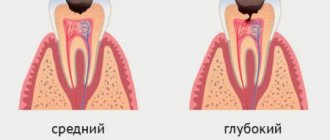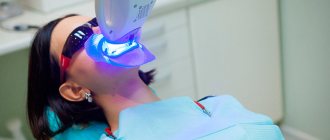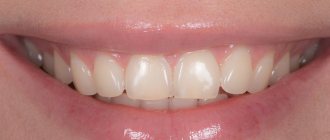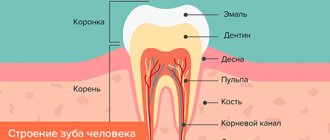Author of the article:
Soldatova Lyudmila Nikolaevna
Candidate of Medical Sciences, Professor of the Department of Clinical Dentistry of the St. Petersburg Medical and Social Institute, Chief Physician of the Alfa-Dent Dental Clinic, St. Petersburg
Today, there are many ways to whiten teeth in dentistry. Anyone who wants to get a delightful Hollywood smile will definitely find the most convenient and affordable option for themselves. You can change the color of your teeth a couple of shades to a healthy shade with professional cleaning, or you can achieve a snow-white smile with more serious cosmetic procedures. It all depends on your taste, desires and health. In any case, you can easily find the best method with the help of your dentist.
It must be remembered that whitening is a serious procedure that does not always have a positive effect on dental health. Therefore, it is important to take the choice of method and subsequent care seriously.
Let's talk about the differences, pros and cons of in-office whitening methods to help you navigate their diversity.
Professional cleaning
Cleaning your teeth from plaque and hard deposits will return them to a healthy natural color, which, of course, will not be white, but definitely a tone or two lighter than without cleaning. In addition, such hygiene is very good for health. It reduces the risk of caries and other diseases. WHO recommends cleaning once or twice a year.
The most popular and effective methods:
- Airflow - plaque is removed using a special device that delivers a solution with crushed abrasive under pressure. This allows you to eliminate dark plaque that occurs due to consumption of coffee, tea, soda and other coloring foods, as well as due to exposure to cigarette smoke. As a result, the natural color of the teeth returns. This procedure can also serve as a preparatory step for cosmetic whitening.
- Ultrasonic cleaning is performed by a device (scaler) that generates ultrasonic vibrations that affect the enamel surface. This method can get rid of not only staining plaque, but also tartar. The procedure is completely safe.
Contraindications
Whitening incisors has a number of contraindications:
- The period of pregnancy and breastfeeding due to the possible negative impact on the baby.
- Age up to 16 years, since in childhood the enamel is still forming and it is undesirable to influence it.
- If you are allergic to the components of the gel.
- In the presence of pathology of the oral cavity. First, treatment is carried out.
- Severe demineralization. Treatment with gel will worsen the condition.
- If your teeth are very sensitive, hydrogen peroxide enhances the sensitivity.
- In the presence of oncological pathology in the acute stage.
- For severe mental disorders, claustrophobia, fear of the dentist.
- Presence of a filling on the front incisor. The filling will not whiten as well as a tooth and a stain will remain. In this case, veneers are used.
Almost all contraindications are temporary; after they are eliminated, the session can be performed.
Methods of teeth whitening in dentistry
Chemical bleaching
A very common method that involves applying a gel with active ingredients to the teeth. It is first necessary to protect the gums and other soft tissues so that the substance does not cause a burn. The gel is kept on the teeth for 30 to 60 minutes, during which time active oxygen destroys plaque and changes the color of the enamel. As a result, it is possible to lighten teeth by 4 to 12 shades in one procedure. The method is not suitable for whitening cracks and chips; it is most effective if you have yellow enamel. On gray teeth the result will be less impressive. If you want to achieve a bright Hollywood smile, multiple sessions may be required.
Ultrasonic whitening
It looks like a chemical, only the gel applied to the teeth is activated under the influence of ultrasound. Oxygen released from the composition changes the color of the enamel.
Laser whitening
Laser whitening has become very popular due to its effectiveness and safety. It is suitable even for those who have chips and scratches on their enamel. The procedure is painless and guarantees lasting results for a long time.
The session goes as follows:
- A special gel based on sodium chloride or hydrogen peroxide is applied to the surface of the teeth; it also contains fluorides, minerals and substances that accelerate the effect of photons.
- Next, the gel is activated by exposure to a beam of diode, argon, neodymium, erbium or carbon dioxide lasers.
- During laser exposure, an active substance is released from the gel, which penetrates the dentin and enamel, making the tooth lighter.
Thanks to the use of modern technologies, the procedure does not take much time. The device adjusts the degree of impact on each tooth individually so that the result is uniform.
During the session, a slight tingling sensation may be felt in the treated area. Afterwards, the teeth do not become more sensitive, and with proper care, the whiteness remains for up to five years.
Photobleaching
Photobleaching of enamel can be done in various ways, which mainly differ in the composition of the gel used.
Today's popular ZOOM systems include the following steps:
- The gums are treated with a specialized protective material.
- A proprietary composition containing non-concentrated hydrogen peroxide is applied to the teeth.
- The enamel is illuminated with a special ultraviolet lamp.
- When exposed to light, oxygen is released from the active composition, which penetrates through the enamel and dentin, breaks down the pigment, removing the yellow or gray tint.
- Next, to prevent the occurrence of hypersensitivity, a remineralizing drug is applied.
Sometimes discomfort may appear after the procedure, but it will go away in no more than a couple of days.
Another popular procedure is Luma-Arch, it is similar to the previous one, but allows you to whiten even problem teeth. Therefore, those with sensitive teeth, cracks and chips in the enamel can safely use this method.
All photobleaching methods are effective and high quality. The procedure takes little time and causes minimal damage to the enamel.
Alternative technologies
Teeth whitening using special gels is not always possible. But no one canceled the desire to make a snow-white smile. This is why alternative methods such as bonding and veneers are so popular.
Bonding
Dental bonding involves applying a special polymer material to the tooth that is as close as possible to the desired tooth color. It is exposed to a special light source, due to which the polymer is firmly connected to the surface of the tooth. With bonding you can change not only the color, but also the shape of your teeth.
It is suitable for the following tasks:
- Recovery after caries;
- Restoration of teeth with chips and cracks;
- Changing the shape and size of teeth;
- Covering the root of a tooth exposed due to gum recession.
Bonding requires virtually no preparation and is often performed without any anesthesia. Typically, processing one tooth takes from 30 to 60 minutes.
The advantages of the method are its affordable cost and minimal damage to tooth enamel.
Veneers
Veneers are a more expensive and long-lasting way to create a Hollywood smile. Special plates are made individually and then attached to the surface of the tooth. Their use also makes it possible to change both color and shape. Veneers are attached with a special adhesive composition.
Internal whitening
In cases where it is necessary to lighten one tooth, for example, if it has darkened due to damage, the internal bleaching method is used. The tooth is drilled, an active substance is injected inside, and the hole is filled with a temporary filling. The procedure can be carried out in several sessions, eventually a permanent filling is placed on the whitened tooth.
Professional approach
Our clinic prefers the OPALESCENCE whitening system manufactured by Ultradent. We also use in practice and offer patients Rembrandt oral hygiene products. Opalescence, Rembrandt and Colgate are among the few whitening systems that are recognized and trademarked by the American Dental Association (ADA). The Opalescence teeth whitening system is registered by the Ministry of Health of the Russian Federation. Opalescence gel contains 20% water, which helps to avoid hypersensitivity or reduce it, without drying out or dehydrating the enamel. The active ingredient in the Opalescence system is carbamide peroxide. Whitening pastes contain various flavoring additives - neutral, banana, menthol and watermelon flavors. Various concentrations of urea peroxide are available (Opalescence 10%, 15%, 20%) with and without fluorine. 35% Opalescence X-tra with carotene is intended for whitening only in the doctor's chair. The procedure for using the home version of Opalescence is not complicated, but requires strict adherence to the instructions. On the first visit, the dentist determines the initial color of the teeth, studies the medical history, removes dental plaque, and takes impressions of the dentition for subsequent production in the laboratory of individual aligner reservoirs in which the whitening gel will be placed. On the second visit, the mouth guards are tried on, they are adjusted, the patient is taught the technique of applying the gel, the procedure for use, the daily or night protocol for use is explained, and a particular toothpaste is recommended. On the third visit, the achieved result is assessed. The whitening effect is comfortable for the patient and others when the shade of the teeth is lightened by 2-4 tones. Attention!
Filling materials are not bleached. Old fillings need to be replaced, since the whitened teeth will be much lighter, but this should be done no earlier than after 14-15 days. During this time, all cabamide peroxide leaves the tooth tissue, and the shade of the enamel stabilizes. Then you can proceed to the restoration of teeth and select the shade of the composite material that matches the shade of the bleached enamel.
Effective methods of teeth whitening at home
It is also possible to whiten your teeth professionally at home, but to do this you need to consult a dentist. Home enamel lightening is similar to in-office chemical bleaching. An active gel based on hydrogen peroxide is also used here, only its concentration is much lower. Therefore, to get a snow-white smile, you will have to carry out the procedures for about two to three weeks, and you will notice the first results around the fourth day.
The method involves wearing special trays every day that are filled with a whitening solution.
Photos of celebrities before and after dentist work
Many Western stars experienced serious problems with the beauty of their smile. In the photo accompanying the article you can see what they looked like before and after the dentists’ work:
- Actress Scarlett Johansson is forced to wear veneers. Now Scarlett has one of the most beautiful smiles.
- Matthew Lewis spent tens of thousands of dollars to make his teeth straight and white. Now Matthew Lewis's teeth are his pride.
- Miley Cyrus wore braces for a long time. This helped make her teeth look beautiful.
Domestic stars also surprise with their beautiful smiles:
- Dmitry Nagiyev is considered by many to be the standard of a stellar smile.
- Timati once amazed fans with “golden” dental overlays. Perhaps the rapper previously believed that men's teeth should be exactly like this.
- Ksenia Borodina managed to achieve a Hollywood smile with the help of veneers.
- At the same time, Bianca’s dentition, although healthy, cannot be called ideal.
How to care for your teeth after whitening
After you make your smile snow-white, you will need to observe oral hygiene more carefully, of course, if you want the result to last for a long time.
During the first 48 hours, you must avoid foods that stain the enamel. Eliminate the following foods:
- Chocolate;
- Coffee;
- Tea;
- Juices, fruit drinks, red wine;
- Lemonades and sodas;
- Confectionery products containing dyes;
- Beets and carrots;
- Adjika, ketchup, soy sauce, etc.
In addition, it is very advisable to refrain from smoking for two days. As a last resort, use an electronic cigarette. Next, for two weeks you need to reduce the number of cigarettes you smoke as much as possible.
Daily hygiene plays an important role in maintaining white teeth. Brush your teeth at least twice a day, and preferably after every major meal. Be sure to use dental floss to prevent food debris from accumulating in areas that are difficult to reach with a brush. The use of rinses is also recommended; this will more effectively combat the growth of harmful bacteria, soothe the gums and help maintain whiteness.
For cleaning, it is best to use whitening and remineralizing pastes.
For example, the professional toothpaste “ASEPTA PLUS” Gentle Whitening is designed for effective and safe teeth whitening without restrictions on the period of use.
The product guarantees enamel lightening by 1.5 tones within 4 weeks of use, as well as a significant (3.4 times) increase in anti-caries effectiveness.
Why do teeth turn yellow and darker?
The hard tissues of the tooth consist of two layers - translucent enamel and underlying darker dentin. Over the course of life, the enamel on the teeth becomes thinner, which causes the darker layer of dentin to increasingly affect the overall color of the teeth. It is also important that dentin itself (with age) tends to become darker, thereby changing the optical properties of teeth.
Secondly, personal habits regarding the consumption of various foods and drinks are of great importance -
- tobacco use,
- black tea and coffee,
- red and white wine,
- carbonated drinks,
- berries and other foods rich in dyes,
- sauces (soy, tomato, curry).
Thirdly, teeth acquire a duller, grayer shade as a result of their depulpation (removal of the nerve and subsequent filling of the canals). Fourthly, after filling the root canals, the tooth may acquire a bluish color, which occurs as a result of mistakes and negligence of the dentist, if at the time of introducing filling materials into the root canals, traces of blood remain on their walls.
Clinical researches
Clinical studies have proven that regular use of professional toothpaste ASEPTA PLUS Gentle whitening for a month allows you to lighten tooth enamel by 1.5 tones, increases anti-caries effectiveness by 3.4 times and increases enamel remineralization by 2.6 times.
Sources:
- Report on determining/confirming the preventive properties of toothpaste “ASEPTA PLUS” GENTLE WHITENING” Author: doctor-researcher A.A. Leontyev, head Department of Preventive Dentistry, Doctor of Medical Sciences, Professor S.B. Ulitovsky First St. Petersburg State Medical University named after. acad. I.P. Pavlova, Department of Preventive Dentistry
- Report on the determination/confirmation of the preventive properties of personal oral hygiene products “ASEPTA PLUS” Remineralization doctor-researcher A.A. Leontyev, head Department of Preventive Dentistry, Doctor of Medical Sciences, Professor S.B. Ulitovsky First St. Petersburg State Medical University named after. acad. I.P. Pavlova, Department of Preventive Dentistry
- Clinical studies of antisensitive toothpaste “Asepta Sensitive” (A.A. Leontyev, O.V. Kalinina, S.B. Ulitovsky) A.A. LEONTIEV, dentist O.V. KALININA, dentist S.B. ULITOVSKY, Doctor of Medical Sciences, Prof. Department of Therapeutic Dentistry, St. Petersburg State Medical University named after. acad. I.P. Pavlova
- The role of anti-inflammatory rinse in the treatment of periodontal diseases (L.Yu. Orekhova, A.A. Leontyev, S.B. Ulitovsky) L.Yu. OREKHOVA, Doctor of Medical Sciences, Prof., Head of Department; A.A. LEONTIEV, dentist; S.B. ULITOVSKY, Doctor of Medical Sciences, Prof. Department of Therapeutic Dentistry of St. Petersburg State Medical University named after. acad. I. P. Pavlova
- Report on determining/confirming the preventive properties of toothpaste “ASEPTA PLUS” COFFEE and TOBACCO Author: doctor-researcher A.A. Leontyev, head Department of Preventive Dentistry, Doctor of Medical Sciences, Professor S.B. Ulitovsky. First St. Petersburg State Medical University named after. acad. I.P. Pavlova, Department of Preventive Dentistry
Why are whitening pastes needed?
Does it follow from all of the above that whitening toothpastes are harmful and absolutely useless? Of course not. More precisely - not all. Some professional whitening toothpastes are able to maintain the effect of in-office whitening and cleaning due to the presence of hydroxyapatites - microelements that help restore enamel and prevent plaque formation.
Also, some whitening toothpastes can help heavy smokers, coffee lovers, lovers of strong tea and red wine - by dissolving a thin colored film and discoloring plaque. However, only your dentist can choose the right toothpaste for you. Such a paste, first of all, should not contain a large number of highly abrasive particles. You also need to remember that any whitening toothpastes are contraindicated for people with hypersthesia - increased sensitivity of teeth, children and adolescents with mixed dentition, as well as pregnant women.
Where to get the smile of your dreams?
How and where do you get snow-white teeth like stars? To carry out professional whitening, you need to contact a clinic that has the appropriate equipment and experienced specialists. Teeth are whitened by a dental hygienist, but this procedure can also be performed by a dental therapist - contacting any of these doctors will allow you to get teeth like a star.
The installation of veneers, lumineers and crowns is carried out by an orthopedic dentist, and implantation is carried out by an implantologist. If your bite needs correction with braces, you should first visit an orthodontist.
Which star gave himself a snow-white smile?
It is quite difficult to get an answer to this question from the celebrities themselves. But if you carefully examine the smiles of the stars, it becomes clear that almost every famous person undergoes whitening on a regular basis. And if he doesn’t, then he gets veneers or lumineers to make his appearance even more attractive and not lose popularity. Only a few can boast of ideal white and naturally straight teeth.
If we turn to world stars with a “Hollywood” smile, which they acquired some time after they became very popular, then we can focus on the following personalities - Marilyn Monroe, Tom Cruise, Julia Roberts, Madonna, George Clooney, David Beckham , Emma Watson and many others.
